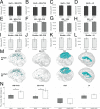The effect of prolonged spaceflight on cerebrospinal fluid and perivascular spaces of astronauts and cosmonauts
- PMID: 35412862
- PMCID: PMC9169932
- DOI: 10.1073/pnas.2120439119
The effect of prolonged spaceflight on cerebrospinal fluid and perivascular spaces of astronauts and cosmonauts
Abstract
Long-duration spaceflight induces changes to the brain and cerebrospinal fluid compartments and visual acuity problems known as spaceflight-associated neuro-ocular syndrome (SANS). The clinical relevance of these changes and whether they equally affect crews of different space agencies remain unknown. We used MRI to analyze the alterations occurring in the perivascular spaces (PVS) in NASA and European Space Agency astronauts and Roscosmos cosmonauts after a 6-mo spaceflight on the International Space Station (ISS). We found increased volume of basal ganglia PVS and white matter PVS (WM-PVS) after spaceflight, which was more prominent in the NASA crew than the Roscosmos crew. Moreover, both crews demonstrated a similar degree of lateral ventricle enlargement and decreased subarachnoid space at the vertex, which was correlated with WM-PVS enlargement. As all crews experienced the same environment aboard the ISS, the differences in WM-PVS enlargement may have been due to, among other factors, differences in the use of countermeasures and high-resistive exercise regimes, which can influence brain fluid redistribution. Moreover, NASA astronauts who developed SANS had greater pre- and postflight WM-PVS volumes than those unaffected. These results provide evidence for a potential link between WM-PVS fluid and SANS.
Keywords: brain; microgravity; perivascular space; spaceflight; spaceflight-associated neuroocular syndrome.
Conflict of interest statement
The authors declare no competing interest.
Figures


Comment in
-
The effect of long-duration spaceflight on perivascular spaces within the brain.Proc Natl Acad Sci U S A. 2022 Aug 9;119(32):e2207724119. doi: 10.1073/pnas.2207724119. Epub 2022 Jul 18. Proc Natl Acad Sci U S A. 2022. PMID: 35858378 Free PMC article. No abstract available.
-
Reply to Wostyn et al.: Potential models for perivascular space (PVS) enlargement and spaceflight-associated neuro-ocular syndrome (SANS).Proc Natl Acad Sci U S A. 2022 Aug 9;119(32):e2208241119. doi: 10.1073/pnas.2208241119. Epub 2022 Jul 18. Proc Natl Acad Sci U S A. 2022. PMID: 35858379 Free PMC article. No abstract available.
References
-
- Kramer L. A., et al. , Intracranial effects of microgravity: A prospective longitudinal MRI study. Radiology 295, 640–648 (2020). - PubMed
-
- Van Ombergen A., et al. , Brain tissue-volume changes in cosmonauts. N. Engl. J. Med. 379, 1678–1680 (2018). - PubMed
-
- Roberts D. R., et al. , Effects of spaceflight on astronaut brain structure as indicated on MRI. N. Engl. J. Med. 377, 1746–1753 (2017). - PubMed
MeSH terms
Grants and funding
LinkOut - more resources
Full Text Sources
Medical
Research Materials

